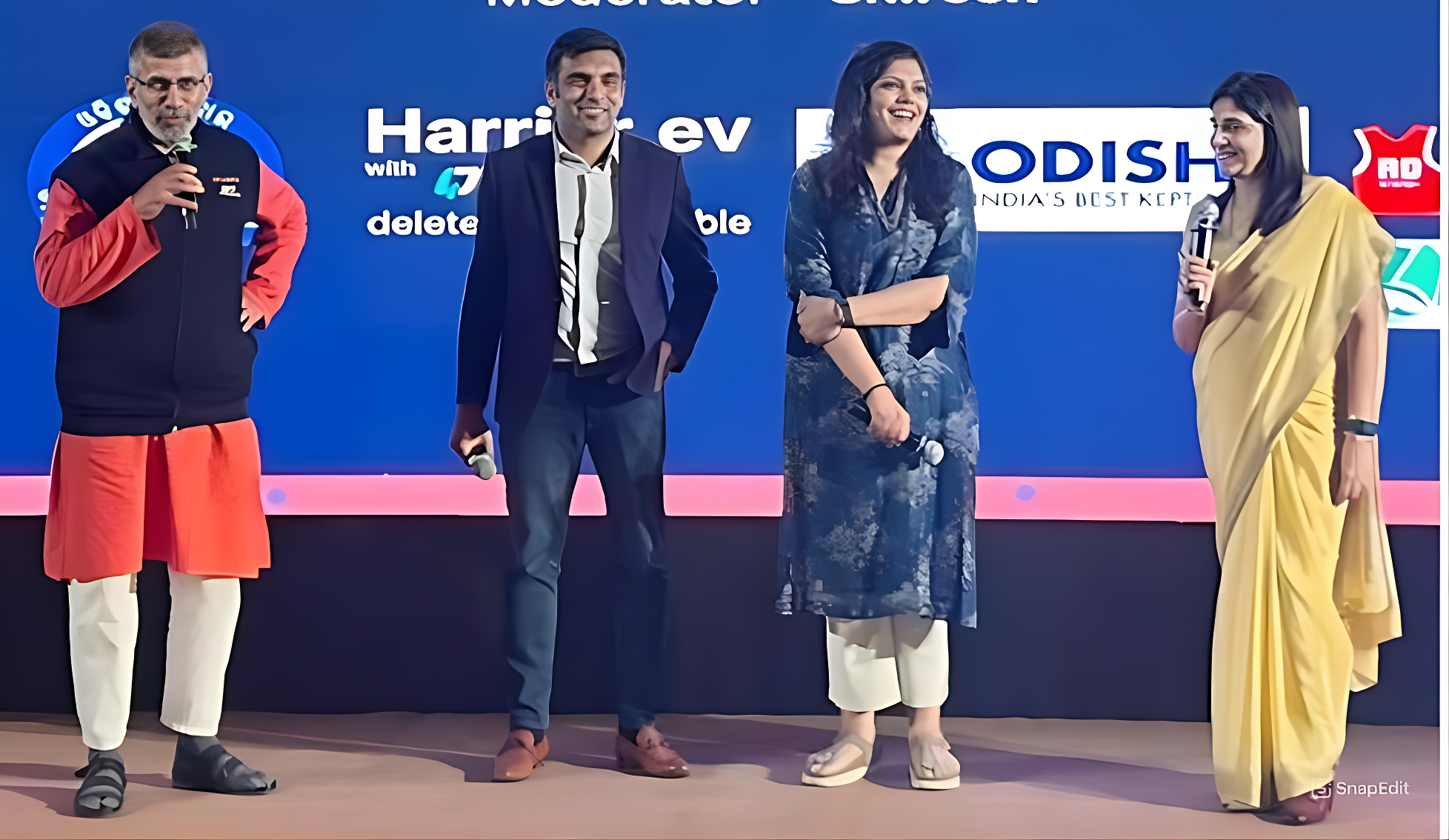New Delhi: Behind every award lies a long chain of unseen conversations, tense debates, quiet conviction, and intellectual honesty. Session 9 at the Ekamra Sports Literature Festival peeled back the curtain on that invisible world. What unfolded on stage was not merely a technical discussion about judging books, but a rare, transparent journey into how four jury members think, read, negotiate, and ultimately shape the literary recognition that so many authors aspire to.
The panel brought together an eclectic and experienced team: author and podcaster Amrita Tripathi, Group Consulting Editor of TV Today Digital B. V. Rao (represented in the session by co-founder Shireen Sethi), DreamSports Foundation CEO and football author Neel Shah, and policy analyst and long-time sports enthusiast Dr. Ajit Kanitkar. Moderated by Sethi, the conversation explored the making of the Sports Book Awards with a candor that rarely emerges from jury rooms.
What became immediately clear was that the awards at Ekamra are not casual endorsements. They are the product of months of work, dozens of readings, extensive Excel sheets, independent assessments, and a surprising alignment of opinions despite the diversity of backgrounds. And most importantly, they come from a place of respect—for writers, for research, for sports, and for the evolving craft of sports literature.
The Awards as the Heart of The Festival
Introducing the session, Sethi made a point that set the tone for the entire discussion: the Ekamra Festival exists for authors. Everything else—panels, discussions, audiences—revolves around the written word. The Sports Book Awards have therefore become the festival’s signature intellectual commitment.
She also clarified a detail often unknown to audiences: nominations do not come from the jury, but from publishers. It is the publishing houses that submit titles; the jury merely reads, debates, and decides.
This year’s panel brought what Sethi described as “rigor.” They read deeply. They documented opinions. They produced spreadsheets. They argued. And most importantly, they did all of it in isolation; each jury member submitted their evaluation without knowing what the others had chosen. Only after the submissions did the convergence—or divergence—of opinions become visible.
Passion, Evolution, and the Changing Landscape of Sports Writing
As the conversation opened, Sethi asked Tripathi what stood out for her during the process of reading across six categories. Tripathi, an author of seven books and the only member of the panel without a formal sports background, brought an outsider’s clarity.
For her, the most striking element was passion—the authors’ passion for their subjects, their sports, and their stories. But she also highlighted something deeper: the transformation of sports writing in India. The books the jury received were no longer limited to cricket or biographical tales of sporting legends. They included works on badminton, sports psychology, sports science, chess, wrestling, and even children’s narratives. For Tripathi, this evolution signaled both a diversification of interest and a maturation of the publishing ecosystem.
What caught her eye most, however, was craft—editing, curation, structure, and the ability to tell a compelling story. Passion alone wasn’t enough; the narrative had to hold.
The Author’s Lens: Writing for Everyone, Not Just Enthusiasts
Neel Shah, who has authored two books himself, brought a dual perspective: that of a writer and that of an academic. His sympathy for authors was immediate and heartfelt. Writing, he said, is the easy part; the editing, publishing, and marketing are far harder.
But as a reader, Shah held firm to one principle: a book must be readable even for someone who knows nothing about the sport. He judged each title not merely as a specialist, but as a general audience member. Would a reader unfamiliar with this sport stay engaged? Would they care enough to turn the page? Would the story hold beyond technical detail?
Some books, he felt, had strong subject matter but became too niche or too dense for the average reader. Others struck a balance, combining depth with accessibility. It was the latter that tended to stand out in his evaluations.
Diversity, Depth, and the Smell of a Real Book
Dr. Ajit Kanitkar, who has served on the Ekamra jury for three consecutive years, provided the perspective of continuity. He had seen around 50 books across his earlier terms, and this year’s collection felt refreshingly diverse to him.
For Kanitkar, two things never changed: Sethi’s annual call from a different country asking if he would join the jury again, and his own insistence on receiving physical books because he prefers to “smell the book” rather than read a PDF.
But what had changed, he said, was the subject matter. The submissions were now spanning wide: psychology, mental health, strength conditioning, children’s literature, non-cricket sports, women’s journeys, and stories from rural India. This diversity mirrored a larger truth—that India is increasingly acknowledging its multi-sport culture, not just its cricketing worship.
He also introduced the concept of inter-rater reliability—a statistical measure of how consistently a group evaluates something. Kanitkar stressed that despite the jury’s varied backgrounds, they found themselves aligned in surprising ways. This unanimity, in his view, reflected not uniform thinking but a shared sensitivity to good storytelling, strong research, and narrative integrity.
Children’s Books: A Category That Deserves to Exist
One of the revelations this year was the quality of children’s sports books. Shah spoke of two titles that made a strong impression, especially Khushi Kid, a wrestling-themed story told through the eyes of a young girl.
He admired how the book introduced children to the realities of rural sports ecosystems—poverty, gender bias, parental struggle—without overwhelming or discouraging them. It conveyed life lessons while remaining playful and accessible.
The panel agreed that children’s sports writing deserves its own category in future editions of the festival.

Editing, Readability, and the Craft of Shaping a Manuscript
Tripathi, drawing from her years in journalism and publishing, answered a crucial question raised by Shah: do Indian sports books need better editing?
Her answer was measured but firm. Readability matters enormously, she said, and some manuscripts showed signs of being rushed—perhaps due to market pressure or the publisher’s desire to capitalize on a timely story. She argued that authors often have the passion, but they need editorial support to refine structure, pacing, and clarity.
For Tripathi, good storytelling is a collaborative process. The best books this year showcased that collaboration; the weaker ones showed its absence.
The Weight of Research and the Power of Fieldwork
One theme that united all jury members was respect for research. Shah, in particular, praised books that showed evidence of extensive fieldwork—authors traveling across states, interviewing athletes, observing training camps, and spending months collecting primary data.
He acknowledged the difficulty: most writers have full-time jobs and pursue writing on the side. Yet some submissions demonstrated significant commitment. Those books, he said, earned admiration not merely for their narratives but for their methodology.
Tripathi and Kanitkar echoed the sentiment. In categories like football and psychology, the strongest entries were those backed by rigorous research.
Mental Health, Sports Psychology, and an Emerging Trend
This year saw the first major entries focused on sports psychology and sports science. Tripathi felt this was not just a growing trend but a necessary one. Post-pandemic India has seen an explosion in discussions around mental well-being, and athletes—from elite icons like Virat Kohli to grassroots performers—have spoken openly about pressure, anxiety, burnout, and emotional resilience.
For Tripathi, these books served a dual purpose: they educated readers on the mental demands of sport, and they helped destigmatize conversations around mental conditioning. She argued that these categories deserve dedicated space in future awards.
Kanitkar expanded the point with a broader lens. India is preparing for the 2036 Olympics, he said, and if the country wants to build a robust sports culture, it must invest not only in training facilities but also in psychological development and values education. He referenced a recent study on Olympic values among Indian youth and expressed optimism that festivals like Ekamra could nurture a grassroots shift in mindset.
A Festival Where Stories Are Born
Towards the end, Shah offered an unexpected but intimate observation. He said that in more formal sports conferences, conversations often felt stiff and transactional. Ekamra was different. People here told stories. They shared journeys. They opened up.
He recounted meeting someone earlier in the day whose personal experience in Indian football, he felt, could easily be a book. And this, he said, is what makes Ekamra special: the next great sports book may be born not in a library or a stadium, but in a simple conversation at this festival.
Tripathi agreed, noting how the morning’s young athletes had moved her with their honesty and resilience. Such stories, she said, need more platforms, more visibility, and more literary support.
A Jury’s Work, A Reader’s Reward
As the session closed, Sethi thanked the jury and acknowledged the absence of B. V. Rao, whose inputs shaped the final decisions.
What the audience witnessed over the previous hour was not merely a panel discussion but a revelation of process. It showed that the awards are not accidental, not political, not ornamental. They are the product of careful reading, informed debate, and steadfast commitment to fairness.
And perhaps most importantly, they reflected a shared belief across the panel: sports literature in India is growing, diversifying, and maturing—and the Ekamra Sports Literature Festival is helping shape that evolution.
The Sports Book Awards that followed carried that belief forward, honoring not just the winners but the very idea that stories—well researched, well written, and deeply felt—deserve to be celebrated.





